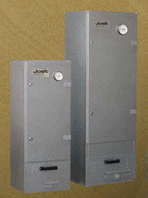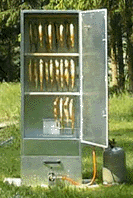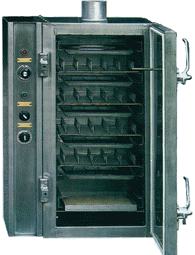|
****JavaScript based drop down DHTML menu generated by NavStudio. (OpenCube Inc. - http://www.opencube.com)****



|
| ! |
| AFRICABIZ
VOL 1 - ISSUE: 86
JUNE
15 - JULY 14, 2006
Previous
Issue
Editor: Dr. Bienvenu-Magloire Quenum
Click here for contact & support console
| | A
WORD FROM THE EDITOR
| | |
|
Dear visitor and international investor,
We
warmly welcome you, if this is
your first visit to Africabiz
Online - The ultimate newsletter
on trading and investing in 49
sub-Saharan African countries.
If you are a regular and faithful
reader, welcome back.
In a previous delivery, guest author David Coffman explained why one needs Business Planning And Not A Business Plan to stress out the point that to run successfully a business, it is important to go beyond drafting only a Business Plan. It is important, to keep that Business Plan alive, updating it periodically several times during an operating year to have an exact control board to run the business, drive it to success and increase the bottom line.
That seems to be a logic way of doing business. However, in African countries most businesses are established without even drafting a comprehensive Business Plan to start with. People get a promising business idea and just go ahead investing.
That way of establishing a business explains why most "entrepreneurs" failed
in Africa. That also explains (partly) why developing strategies carried out since 50 years by sub-Saharan African countries yielded meagre results far below the expectations of the governments and the citizens.
The equation is simple: If one does not have a plan, or if one plans poorly - in any line of business - one is simply heading for disaster. Guessing and taking one's illusions for facts are sure recipe to crashing into the wall!
As for popular saying: He, who sail not knowing where to go, would never
have a fair wind. Or in other words: He, who does not know where to go, would
take any road that leads nowhere. That means without a proper planning, you
would not reach your "expected" destination and your achieved
results will always be far below your expectations.
- A PROFIT-MAKING BUSINESS CAN COLLAPSE FOR LACK OF PROPER PLANNING
Let us consider the business opportunity of current delivery: A small-scale operation to (cold) smoking
tilapia and catfish.
Apparently it is a very simple undertaking. One put the fresh fish into the smoker and get the final products that are smoked tilapia and smoked catfish.
Both fresh fish species, however, weight differently. When harvested, catfish weight twice tilapia - in average. So a producer has to know the exact weight of each final processed product to calculate the respective production costs, and consequently the selling prices. If one does not calculate the exact production costs and just guess the selling prices to be applied to each category of final product, one might eventually, sooner or latter run into trouble against the competition.
Indeed, if competitors managed to have the exact figures, then they know exactly when and how to slash pricing to keep non-planning producers out of the market and kill their business.
All this to assert the fundamental point that even if a business seemingly (at nose's guess!) shows the potential to yielding a fat bottom-line, one needs to draft first a comprehensive business plan and subsequently to keep that business plan alive, dynamically and periodically updating it to have an exact picture about (among other things) the operating expenses and particularly about Cash Flow's evolution.
Many private (and developing) projects failed in African countries simply because of poor planning, inaccurate operating expenses estimates, confusion over staff and management respective roles and responsibilities, and poor communication between staff and management; and between the several departments of management - not to forget poor marketing and deficient communication with potential customers.
To review other aspects of the matter click here to read more about: "Business Owner's Essentials - The 5 Biggest Challenges for Today's Business Owner."
-
Contributor's Guidelines
are here to review. Your
contribution on "How emerging nations
and particularly African countries
/ entrepreneurs could bridge the developing
gap" is
welcome.
| Your
feedback / objection / contribution is welcome. Visit WorldWide
BizCenter,
and choose General
Information (as topic) to
create a thread for discussion. On the top of the WorldWide BizCenter page,
there is a HELP link to assist you making an efficient
use of the discussion board. This
link also is useful |
Many thanks for dropping by and see you here on July 15, 2006.
Dr.
B.M. Quenum
Editor
of AFRICABIZ

|
| |
| BUSINESS
OPPORTUNITIES IN AFRICA
| |
-
Several business opportunities - component parts of the Integrated Developing Scheme described in Africans, Stop Being Poor! are listed in following table.
| a-
SHEA BUTTER (5,
6, 7,
11, 12,
13)
b- BLUE GOLD (14,
15, 16,
17, 18,
19)
c- FREEZE-DRIED PAPAIN (20,
21, 22
and here)
d-
KENAF (23,
24)
e- VEGETABLE OIL (25,
26, 27,
28)
f- CEREALS (30,
31, 32,
33)
g- FRUITS (34,
35, 36,
37, 38,
39, 40,
42, 43,
44, 45,
46)
h- ESSENTIAL OILS (47,
48, 49,
50, 51,
52)
i- ROOTS & TUBERS (54,
55, 56,
57, 58,
59, 60,
61, 62,
63, 64)
j-
FOWL BREEDING (66,
67, 68,
69, 70,
71, 72, 73, 74, 75, 76)
k- FISH FARMING (78, 79, 80, 81, 82, 83, 84, 85, 86, 87 |
|
-
FISH FARMING AS BUSINESS OPPORTUNITY: PART
IX - ECONOMICS BRIEFS ABOUT A SMALL-SCALE OPERATION TO SMOKING TILAPIA AND CATFISH
As explained in last delivery (click on link below) the demand for fresh and processed fish far exceeds offer. Therefore one can assert that fish production is an economic activity that could assist boosting the developing in African countries.
After the preliminaries to processing fish to added valued products, we will now provide briefs about a small-scale operation to processing tilapia and catfish to smoked products.
First step: Cleaning the fish prior to the smoking operation
Fish should be cleaned and scaled immediately after harvesting. The first step to preparing to the smoking operation implies the following (depending on the species): (1) fish is dressed in the round (whole); (2) gutted, split, and beheaded; (3) filleted; (4) halved; or (5) cut into pieces with or without the skin. Traditional practitioners in Africa smoke Tilapia and Catfish as a whole - catfish being rounded with the tail inside the mouth.
Second step: Brinning the fish that had been prepared in first step
After the first step, the fish is brinned that is it is steeped in a solution of salt, (sugar), water, and spices. The brinning operation helps firm and preserve fish by removing moisture, and it adds flavor to fish flesh. There are all sorts of brinning melanges as many fish processing's operators and individual tastes. The strength of the brine (salt content) determines the type of cure the product receives. Below outlined is a brine composition for tropical countries' consumers taste to handling a batch of 10 kg of fresh fish:
4 liters of water
500 gr of salt
250 gr of brown sugar
6 tablespoons lemon juice
5 tablespoon onion powder
100 ml of concentrated garlic syrup
1 tablespoon of fresh crushed pimento
|
Smoking equipment
Aquaculture Technology (AquaTech) markets all sorts of equipment to breed and process fish. From breeding to scaling machines, filleting machines, several kinds of smokers and vacuum packers, the company market almost everything one needs to operating a fish breeding and processing operation.
  In direct relation to current delivery, AquaTech offers a multipurpose equipment to smoke fish, sausage, meat, poultry in the same oven. (Pictures at the left side of said equipment - closed and opened.) In direct relation to current delivery, AquaTech offers a multipurpose equipment to smoke fish, sausage, meat, poultry in the same oven. (Pictures at the left side of said equipment - closed and opened.)
Up to 300 kg of fish or 200 kg of meat per batch can be smoked and the process takes up to 60 minutes to be completed. Further, the equipment is fuel versatile. It can be powered either by propane-gas or fuel-wood and delivered with both built in. It can operate cold-smoking or hot-smoking processes.
AquaTech proposes in its catalogue an alternative to the above described equipment, which is pictured at the right  side of this paragraph. It is electricity powered and can handle the same quantities of raw materials - meat or fish as the previous system. It features electric smokers with double wall isolation (50 mm), pipe connection, heating coils and thermostat (50-250 °C), switches, and drip-pan. Etc. side of this paragraph. It is electricity powered and can handle the same quantities of raw materials - meat or fish as the previous system. It features electric smokers with double wall isolation (50 mm), pipe connection, heating coils and thermostat (50-250 °C), switches, and drip-pan. Etc.
For the purpose of this delivery we will consider the dual powered (propane-gas and fuel-wood) equipment to estimate investment and operating costs for a small scale smoking operations under the following conditions:
Operating conditions
Alternate batch of 300kg of tilapia and catfish cold-smoked during 60 processing-minutes; 20 minutes interval to load one batch after the finished batch in a dual (wood and propane gas) powered AquaTech equipment (RS-300). Which means 6 (six) cycles per 8-hour working day to handling (300kg x 6) = 1,800 kg per day of fresh tilapia and catfish. Considering the combined weight loss during brinning and the smoking process to be in average fifteen percent for both species of processed fish (tilapia and catfish), the final daily processed production would be: 1,530 kg.
The following table summarizes operating costs.
| Operating Inputs & Costs |
| Inputs |
Daily |
Monthly (24 days) |
Yearly |
Yearly costs (US$) |
| Tilapia (kg) |
900 |
21,600 |
259,200 |
414,400 |
| Catfish (kg) |
900 |
21,600 |
259,200 |
466,560 |
| Brinning mix (liters) |
720 |
17,280 |
207,360 |
42,000 |
| Gas-Propane*(kg) |
11,5 |
276 |
3,312 |
1,596 |
REMARK*: Propane-gas' consumption for AquaTech's RS-300 smoking equipment is approximately 1,920 kg per hour. The daily smoking process of 1,800 kg of fresh fish (per batch of 300 kg per 60 minutes' smoking cycle) would be consuming 1,920 x 6 = 11,520 kg of propane-gas per day. 25 kg of propane gas container cost around US$ 12 (in Benin).
Operators may compare fuel-wood costs to gas-propane's one to make their choice. However, using gas-propane is better as the tasting flavour and quality of produced smoked-fish would remain "constant" from one batch of processed fish to the other.
- ECONOMICS BRIEFS TO SMOKING TILAPIA AND CATFISH - SMALL SCALE OPERATION
Based on previous preliminaries, one has the following table that summarizes the operation's economics:
|
US$ |
|
INVESTMENTS
|
Production Space Layout: cold room, preparation space, brinning tanks, smoking area, storage space for finished products - 200 sq. Plus 100 sq meter space for workers cloakroom. Shelter for propane-gas containers. Small office space. Etc |
40,000 |
Production equipment: One 1,000 liters water tank; 10 plastic basins to brin 100 kg of fish per 24 hours brinning cycle; one AquaTech dual powered (propane gas and fuel-wood) RS-300 smoking apparatus; plus sets of knives. Etc |
15,500 |
Other Production Equipment and Inputs: One pick-up car; 5 barrows; handling equipment, 10 small five kg content plastics basins to handling wastes (fish blood, scales and gutting wastes), plastic overalls for workers, soap bars and scrubbers. Etc. |
25,500 |
Total investment |
81,000 |
|
OPERATING COSTS
|
Operating Expenses: to producing 352 metric tons of smoked tilapia and 397 metric tons of smoked catfish and 60 kg of wastes (dried bowels and blood, crushed scales that could be used for animal feed formulation) including 10 workers salaries and wages. |
950,000 |
| PRODUCTION COSTS |
397 metric tons of smoked catfish (weighting each 298 gram. in average (click here for more about the weight of the fresh fish.) That is 1,332,214 smoked catfish per year for 475,000 US$ production costs. That gives a production cost per fish equals to .360 US$ or per kg. of smoked catfish = |
1,208 |
352 metric tons of smoked tilapia (weighting each each 128 gram. in average (click here for more about the weight of the fresh fish.) That is 2,750,000 smoked tilapia per year for 475,000 US$ production costs. That gives a production cost per fish equals to .173 US$ or per kg. of smoked tilapia = |
1,349 |
| GENERATED REVENUES |
| Catfish: 397,000 x 1,812* US$ = |
719,396 |
| Tilapia: 352,000 x 1,889* US$ = |
665,000 |
| Total = |
1,384,396 |
| GROSS PROFIT |
| GROSS PROFIT |
434,396 |
Fifty percent profit margin had been applied to catfish's cost of production and forty percent to tilapia's one having in mind taxes and other levies that the company would have to pay.
The operation is profit oriented. There is a huge market throughout Africa as most of the time, about 80% of fish harvest is consumed fresh and only the remaining 20% is processed to smoked product by villages' women using craft-made smoking methods. This is a small business opportunity that would boost fresh fish breeding. It is a true "economic catalyst" that would yield all its profit making potential to an African entrepreneur only if it is well planned as here briefly exposed.
Adobe
Acrobat Reader is available here
- Interested parties - private African and international investors /
companies, government
agencies,
international development
agencies - to make contact through the Free Access Support Console available at this link
Contact through the support console will get quickest reply from Africabiz Online's staff, than contact by emails. Click here for contact information. Be advised that first contact should be through the support console to be followed by phone calls. If you are a VIP-Member, use VIP-Members Support Console available here.
Before you consult please click
here to review this clarification |
|

